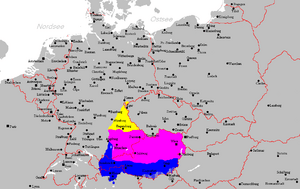Austro-Bavarian language facts for kids
Quick facts for kids Bavarian |
|
|---|---|
| Bairisch | |
| Region | Austria, Bavaria, Germany, Italy |
| Native speakers | 13 million (2005) |
| Language family |
Indo-European
|

Location map of Bavarian
|
|
Bavarian (also called Austro-Bavarian) is a major group of German dialects. These dialects are spoken in mountainous areas. You can find them in parts of Switzerland, Austria, and southern Germany.
Bavarian is a type of High German language. It is similar to, but not the same as, Standard German. However, Bavarian and Standard German have influenced each other a lot. Most people who speak Bavarian also speak Standard German.
The term "Austro-Bavarian" can also refer to a larger group of dialects. This group includes Bavarian itself, plus Cimbrian, Hutterite German, and Mócheno dialects.
Contents
Where Bavarian Comes From
The Bavarian language started with a Germanic tribe called the Bavarii. This tribe created a duchy (a type of kingdom) in the early Middle Ages. This duchy covered much of what is now Bavaria and parts of Austria. Later, the Bavarii tribe slowly moved along the Danube River and into the Alps. This is why Bavarian dialects are spoken in these areas today.
In German, there are two different spellings: "bairisch" and "bayerisch".
- "Bairisch" refers to the language itself.
- "Bayerisch" refers to the state of Bavaria. It's also used in names like BMW.
The spelling "Bayern" for the state came from King Ludwig I. He loved everything about Ancient Greece. The ancient Greek letter "Y" (upsilon) was used instead of "I". But the language kept its original spelling, "Bairisch", with an "I".
Where People Speak Bavarian
Bavarian is spoken in several countries:
- In Bavaria, Germany:
- In Upper Bavaria
- In Lower Bavaria
- In the Upper Palatinate
- In Austria:
- In almost all parts of the country.
- The only exceptions are Vorarlberg and parts of Reutte District in Tirol. In these areas, an Alemannic dialect is spoken instead.
- In Switzerland:
- In the small village of Samnaun, located in Graubünden.
- In Italy:
- In all of the province of South Tyrol.
- By small German-speaking groups in Trento, Veneto (Cimbrian language), and Friuli.
- In Hungary:
- The city of Sopron (also known as Ödenburg) is officially bilingual. This means two languages are used there.
Related pages
Images for kids
See also
 In Spanish: Idioma austro-bávaro para niños
In Spanish: Idioma austro-bávaro para niños



